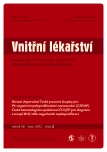Radioiodine 131I therapy of hyperthyroidism on an outpatient basis – safe, effective and economic option
Authors:
J. Jiskra 1; J. Kubinyi 2; Z. Telička 1
Authors‘ workplace:
III. interní klinika 1. lékařské fakulty UK a VFN Praha, přednosta prof. MUDr. Štěpán Svačina, DrSc., MBA
1; Ústav nukleární medicíny 1. lékařské fakulty UK a VFN Praha, přednosta prof. MUDr. Martin Šámal, DrSc.
2
Published in:
Vnitř Lék 2012; 58(2): 94-98
Category:
Original Contributions
Overview
Introduction:
Radioiodine 131I therapy of hyperthyroidism on an outpatient basis is widely accepted over the world. In Czech Republic, however, radioiodine therapy is still not enough used, and has been realized on an inpatient basis to date. Our work is the first analysis of the experiences with radioiodine therapy of hyperthyroidism on an outpatient basis in Czech Republic.
Methods:
Capsule with 550 MBq of 131I was administered orally in 39 hyperthyroid patients (32 women and 8 men, 21 with autoimmune Graves’ hyperthyroidism and 18 with toxic thyroid nodules, mean age 66.8 years). In 32 of them we evaluated effectiveness and complications of therapy after 12–42 months. We also compared financial costs of the radioiodine treatment on an outpatient basis with the treatment in hospitalization and with surgery.
Results:
After the treatment, 9/32 (28 %) patients were euthyroid without thyrostatic/thyroxine treatment, 18/32 (60 %) patients were hypothyroid with thyroxine therapy, 2/32 (6 %) patients significantly decreased doses of thyrostatic drugs. In 2/32 (6 %) patients the treatment was ineffective. The effect of the treatment did not depend on the etiology and severity of hyperthyroidism, but decreased with thyroid volume. Patients with ineffective or only partially effective treatment had median of thyroid volume more than 40 ml. In 1 patient thyroid associated ophthalmopathy was moderately worsened. Other complications were not observed. If we compared financial costs in model with 1 patient, we found that the costs of radioiodine therapy on an outpatient basis (118.7 €) comprise only 16 % of the costs of radioiodine therapy in hospitalization (728 €) and only 25 % of the costs of surgery (475.6 €).
Conclusion:
Radioiodine 131I is effective and safe in the treatment of hyperthyroidism and the therapy on an outpatient basis is much cheaper choice. The therapy with 131I on an outpatient basis is not suitable in patients with thyroid volume more than 40 ml.
Key words:
hyperthyroidism – radioiodine 131I – financial costs
Sources
1. Prinzmetal M, Agress CM et al. The use of radioactive iodine in the treatment of Graves disease. Calif Med 1949; 70: 235–239.
2. Ross DS. Radioiodine therapy for hyperthyroidism. N Engl J Med 2011; 364: 542–550.
3. Vlček P. Karcinom štítné žlázy, pooperační sledování nemocných. In: Vlček P, Neumann J (eds). Karcinom štítné žlázy. Praha: Maxdorf 2002: 220.
4. Horáček J. Terapie benigních onemocnění štítné žlázy radiojódem. In: Límanová J et al (eds). Štítná žláza. Trendy soudobé endokrinologie. Sv. 2. Praha: Galén 2007: 281–297.
5. Wartofsky L, Glinoer D, Solomon B et al. Differences and similarities in the diagnosis and treatment of Graves’ disease in Europe, Japan, and the United States. Thyroid 1991; 1: 129–135.
6. Bartalena L, Marcocci C, Bogazzi F et al. Relation between therapy for hyperthyroidism and the course of Graves’ ophthalmopathy. N Engl J Med 1998; 338: 73–78.
7. Alexander EK, Larsen PR. High dose of (131)I therapy for the treatment of hyperthyroidism caused by Graves’ disease. J Clin Endocrinol Metab 2002; 87: 1073–1077.
8. Nygaard B, Hegedüs L, Nielsen KG et al. Long-term effect of radioactive iodine on thyroid function and size in patients with solitary autonomously functioning toxic thyroid nodules. Clin Endocrinol (Oxf) 1999; 50: 197–202.
9. Nygaard B, Hegedüs L, Ulriksen P et al. Radioiodine therapy for multinodular toxic goiter. Arch Intern Med 1999; 159: 1364–1368.
10. Ceccarelli B, Bencivelli W, Vitti P et al. Outcome of radioiodine-131 therapy in hyperfunctioning thyroid nodules: a 20 years’ retrospective study. Clin Endocrinol (Oxf) 2005; 62: 331–335.
11. Nygaard B, Faber J, Veje A et al. Transition of nodular toxic goiter to autoimmune hyperthyroidism triggered by 131I therapy. Thyroid 1999; 9: 477–481.
12. Lai A, Sassi L, Compri J et al. Lower dose prednisone prevents radioiodine-associated exacerbation of initially mild or absent Graves’ orbitopathy: a retrospective cohort study. J Clin Endocrinol Metab 2010; 95: 1333–1337.
13. Ron E, Boody MM, Becker DV et al. Cancer mortality following treatment for adult hyperthyroidism. Cooperative Thyrotoxicosis Therapy Follow-up Study Group. JAMA 1998; 280: 347–355.
14. Franklyn JA, Maisonneruve P, Sheppard MC et al. Mortality after the treatment of hyperthyroidism with radioactive iodine. N Engl J Med 1998; 338: 712–718.
15. In H, Pearce EN, Wong AK et al. Treatment options for Graves disease: a cost-effectiveness analysis. J Am Coll Surg 2009; 209: 170–179.
Labels
Diabetology Endocrinology Internal medicineArticle was published in
Internal Medicine

2012 Issue 2
Most read in this issue
- Clinical implications of enlargement of left atrium
- Medicines and thyroid gland
- Radioiodine 131I therapy of hyperthyroidism on an outpatient basis – safe, effective and economic option
- Good’s syndrome (thymoma associated hypogammalobulinaemia) – 2 case reports
